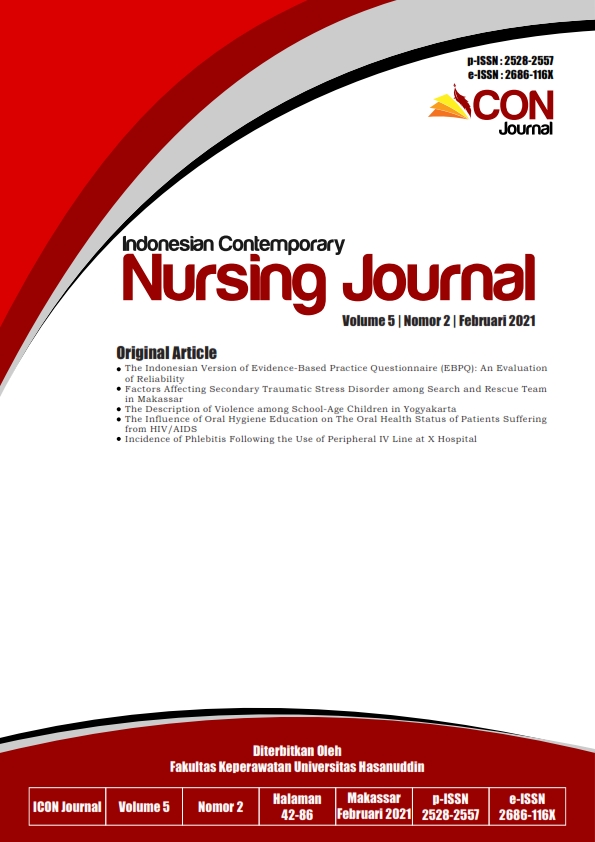Incidence of Phlebitis Following the Use of Peripheral IV Line at X Hospital
DOI:
https://doi.org/10.20956/icon.v5i2.10859Keywords:
Phlebitis Incidence, Peripheral IV line, IV Line InfusionAbstract
Introduction: Intravenous (IV) line infusion therapy is a therapy given to patients who are admitted or having a specific therapy. The IV-line therapy may include fluid therapy, medication administration and blood therapy. Based on the data found in Hospital X, there were 30 incidence of phlebitis in 2017. This study aimed to describe the factors of phlebitis incidence in X hospital. Method: This study was a retrospective study using 50 clinical record of the inpatient patients. The inclusion criteria were all documents of those who are hospitalized at least three days. Result: The result describes three factors following the incidence of phlebitis, such as intrinsic factors, chemical factors, and mechanical factors. The Intrinsic factors included age, gender and medical diagnosis. While Mechanical factors consist of the size of catheter, location and length of infusion. The Chemical factors were of infusion fluid type and infusion rate. Conclusion: The conclusion of this study was the three factors are modifiable factors. Thus, nurses need to assess and evaluate patients’ infusion in order to prevent a higher case of phlebitis. As a recommendation for further study is to analyze the correlation between those factors to the incidence of phlebitis.
References
Brunner, S. (2016). Buku Ajar Keperawatan Medikal Bedah Brunner & Suddarth edisi 8 Volume 1,2. Jakarta: penerbit Buku Kedokteran Indonesia EGC. Water (Switzerland).
Cicolini, G., Manzoli, L., Simonetti, V., Flacco, M. E., Comparcini, D., Capasso, L., Di Baldassarre, A., & Eltaji Elfarouki, G. (2014). Phlebitis risk varies by peripheral venous catheter site and increases after 96 hours: A large multi-centre prospective study. Journal of Advanced Nursing. https://doi.org/10.1111/jan.12403
Do Rego Furtado, L. C. (2011). Incidence and predisposing factors of phlebitis in a surgery department. British Journal of Nursing. https://doi.org/10.12968/bjon.2011.20.sup7.s16
Engbers, M. J., van Hylckama Vlieg, A., & Rosendaal, F. R. (2010). Venous thrombosis in the elderly: Incidence, risk factors and risk groups. In Journal of Thrombosis and Haemostasis. https://doi.org/10.1111/j.1538-7836.2010.03986.x
Fatimah, S. H. & S. (2016). Faktor yang berhubungan dengan kejadian phlebitis di ruang anak RSUD DR. R. Soetrasno Rembang. Motorik.
Health Department of Government of Australia. (2017). Insertion and Management of Peripheral Intravenous Cannulae in Western Australian Healthcare Facilities Policy. https://ww2.health.wa.gov.au/-/media/Files/Corporate/Policy-Frameworks/PublicHealth/Policy/Insertion-and-Management-of-Peripheral-Intravenous-Cannulae/MP38-Insertion-and-Management-of-Peripheral-Intravenous-Cannulae.pdf
Hidayat, A. A. A., Sukadiono, & Wijayanti, E. (2020). Predictor factors of phlebitis incidence for children in hospital private in Sidoarjo, Indonesia. Systematic Reviews in Pharmacy. https://doi.org/10.31838/srp.2020.6.39
Jannah, I., Suhartono, S., & Adi, M. (2016). Prevalensi phlebitis pada pasien rawat inap dengan infus di RSUD Tugurejo Semarang. Jurnal Kesehatan Masyarakat Universitas Diponegoro.
Joae Brett Nito, P., Sari Mulia Banjarmasin, S., & Ahmad Yani, S. (2017). Relationship of age, gender, location insertion and catheter size of incidence phlebitis. Dinamika Kesehatan.
Laudenbach, N., Carie A., B., Klaverkamp, L., & Hedman-Dennis, S. (2014). Peripheral IV stabilization and the rate of complications in children: An exploratory study. Journal of Pediatric Nursing. https://doi.org/10.1016/j.pedn.2014.02.002
Mandal, A., & Raghu, K. (2019). Study on incidence of phlebitis following the use of pherpheral intravenous catheter. Journal of Family Medicine and Primary Care. https://doi.org/10.4103/jfmpc.jfmpc_559_19
Marleni, L., Novayelinda, R., & Dewi, Pristiana, A. (2009). Faktor– faktor yang mempengaruhi kejadian ekstravasasi infus pada pasien anak. Jurnal Ilmiah Ilmu Keperawatan Indonesia.
Nursalam. (2015). Konsep dan Penerapan Metodologi Penelitian Ilmu Keperawatan Edisi 2. In Salemba Medika.
Nyika, M. L., Mukona, D., & Zvinavashe, M. (2018). Factors contributing to phlebitis among adult patients admitted in the medical-surgical units of a central hospital in Harare, Zimbabwe. Journal of Infusion Nursing. https://doi.org/10.1097/NAN.0000000000000265
O’Grady, N. P., Alexander, M., Burns, L. A., Dellinger, E. P., Garland, J., Heard, S. O., Lipsett, P. A., Masur, H., Mermel, L. A., Pearson, M. L., Raad, I. I., Randolph, A. G., Rupp, M. E., Saint, S., & Healthcare Infection Control Practices Advisory Committee (HICPAC). (2011). Guidelines for the prevention of intravascular catheter-related infections. Clinical Infectious Diseases : An Official
Publication of the Infectious Diseases Society of America. https://doi.org/10.1093/cid/cir257
Potter, P. A., & Perry, A. G. (2010). Fundamental Keperawatan (7th ed.).
Ray-Barruel, G. (2017). Infection prevention: Peripheral intravenous catheter assessment and care. Australian Nursing & Midwifery Journal.
Rizky, W. (2016). Analisis faktor yang berhubungan dengan kejadian phlebitis pada pasien yang terpasang kateter intravena di ruang bedah rumah sakit Ar. Bunda Prabumulih. Jurnal Ners Dan Kebidanan Indonesia. https://doi.org/10.21927/jnki.2016.4(2).102-108
Singh, A. K., Dwivedi, R., & Ghaharwar, A. P. S. (2018). Risk factors of thrombophlebitis at infusion sites in patients admitted in surgical ward: A prospective observational study International Surgery Journal. https://doi.org/10.18203/2349-2902.isj20181570
Urbanetto, J. de S., Peixoto, C. G., & May, T. A. (2016). Incidence of phlebitis associated with the use of peripheral IV catheter and following catheter removal. Revista Latino-Americana de Enfermagem. https://doi.org/10.1590/1518-8345.0604.2746
Wayunah, W., Nurachmah, E., & Mulyono, S. (2013). Pengetahuan perawat tentang terapi infus mempengaruhi kejadian plebitis dan kenyamanan pasien. Jurnal Keperawatan Indonesia. https://doi.org/10.7454/jki.v16i2.12
Downloads
Published
Issue
Section
License
Authors who publish with this journal agree to the following terms:Authors retain copyright and grant the journal right of first publication with the work simultaneously licensed under a Creative Commons Attribution License that allows others to share the work with an acknowledgement of the work's authorship and initial publication in this journal.
Authors are able to enter into separate, additional contractual arrangements for the non-exclusive distribution of the journal's published version of the work (e.g., post it to an institutional repository or publish it in a book), with an acknowledgement of its initial publication in this journal.
Authors are permitted and encouraged to post their work online (e.g., in institutional repositories or on their website) prior to and during the submission process, as it can lead to productive exchanges, as well as earlier and greater citation of published work (See The Effect of Open Access).


